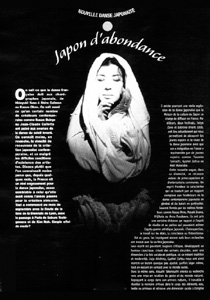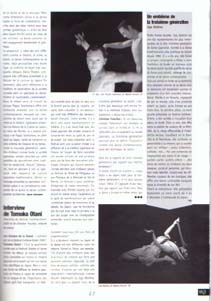Dance Company NUBA/ Press December 2000 Magazine"Les Saisons De La DANSE"
Japan of abundance "A symbol of the third generation " written by Laure Donezan


A symbol of the third generation
Juju Alishina
A diminutive, strong-minded woman, Juju Alishina is one of the most striking representatives of the so-called third generation of Japanese dance. Trained in traditional dance, she has practiced Butoh since 1982.Ten years ago(1990), she created her own company<Nuba>, with the ambition of founding a new style of butoh (post-Butoh), a mix of classicism and contemporary dance.
While her work is based on the Oriental character of her dance, still her style is open-minded and keeps a strong international touch. Married to a Frenchman, she travels throughout the world, and has performed in Japan as well as in Europe or United States. Her last play,la main gauche - Laughing Fist - displayed in the Extrême-Orient festival, is a recreation of a work conceived during a stay in Israel. In this solo, she adopts the many faces of feminity, from the shy virgin to the abdicating empress. Working on feminity and feminism, she brings face to face her personality with the violence society may inflict on her : loss of identity, sadism, rape ... By a resrarch of what hands and face can express - sometimes exhibited, sometimes hidden - she attempts to render evident the two masks which structure our identity - the social one and the intimate one. Playing with various colours of music, she delivers a dance made of contracts, depicting all the diversity of her Self.
Pursuing the metaphor, she will play " la main sourit - the smilling hand -" at the Japanese embassy from the 4th to the 6th of December 2000.
NEW JAPANESE DANCE
Japan of abundance
We know what Japanese choreographers such as Hideyuki Yano, Shiro Daimon or Kazuo Ohno have brought to French dance. We also know that some modern creators,like Susan Burge or Jean-Claude Gallota, have been widely inspired by Japanese dance. On the contrary, we are barely aware of the intensity of the renewal of modern Japanese creation, and thus in spite of the many practical difficulties met by the artists in their daily life. Rather, we should say we were barely aware, because for the last few months, there has been a true enthusiasm in France for Japanese dance, an enthusiasm that may be compared with the enthusiasm of last year for African creation. This phenomenon began in September with the <Route de la Soie de la Biennale de Lyon> and also with the coming of Saburo Teshigawara and Kim Itoh in Paris. Is this simply a fad?
In fact, we may say there is a real explosion of Japanese dance that the <Maison de la culture du Japon> seeks to develop and advertise in France.Two current festival, <Tokyo Zone> and <Extrême-Orient 2000>, allow us to discover the young hopes and the potentialities of Japanese dance as well as the Japanese dancers emigrated France, represented by young hopes like Tsuneko Taniuchi, Gyohei Zaitsu or Maki Watanabe.
The various artists who compose this "New Wave"have nevertheless some orientations and preoccupations in common and make the unity of this new stream. A sprit of protest - one of its characteristics - explains the comolicated relationships with the Founders of modern Japanese dance in general and of Butoh in particular. Often trained by Masters and Founders like Kazuo Ohno, Masaki Iwana, Hijikata Tatsumi or Anzu Furukawa, they took some distance with the spirit of rebellion and the pathos which could have been seen as the dominant colours of japanese arts just after the war. Introspection, work on states of mind and feelings, consciousness or gesture intentionnality are still there, but the quest has changed as Japanese society is evolving too.
Still they adopt a critical behaviour, with a sarcastic sense of humour, creating worlds made of absurdities, mixing social and poetical dimensions, tradition and modernity. Juju Alishina and Gyohei Zaitsu have shown us a Butoh more appeased, even delicate, while deeply penetrated with social preoccupations.....
Interview of Tomoko Otani (Manager of the Extrême-Orient 2000 Festival)
Les Saisons de la Danse: How was this festival born?
Tomoko Otani : This festival of dance and theater enters its fourth year of existence. At the beginning, I especially wanted to introduce Japanese theater in France, and Butoh which is a very specific dance in japan. But it is not easy to show Japanese theater in France because of language problem and others, like the importance of material needed. The festival gradely emphasises Butoh since I wanted, besides, to introduce dancers who are very different from the French dancers of Butoh. This year, there is only one play, there is some"music hall"with famous Japanese popular songs of the sixties and the seventies reviewed to make them acceptable to modern taste and Butoh forms. Solos performed in the festival are aimed at helping the creation of japanese artists in France. An opportunity to introduce them to the public and to allow them to meet each other. some of them, present last year, have participated to the pantomime festival of Perigueux or the Plateaux de la Biennale du Val de Marne. This festival intends to organise true encounters. I worked with Michel Caserta who gave me the experience and the taste of festivals built on encounters and debates. In Japan, it does not work like this, but I insist upon artists, besides their performance, teaching some of their techniques during this festival.
How did you choose the program?
There are many trends in Japan and dance is very different according to the region, Kansai or Tokyo for example. First, I was in touch with managers of theater who made a first regional selection. All are young artists, some not well known, others already internationally recognised like Atsushi Takenouchi or Juju Alishina. Most of them come from the third generation of Butoh, in other words most of them were trained in accordance with Hijikata method but their way of expression has greatly evoled.